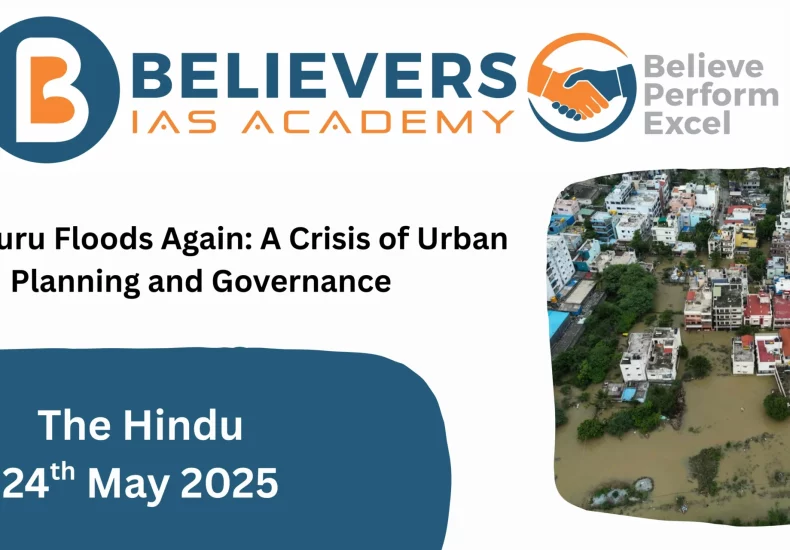
Bengaluru Floods Once more: A Disaster of City Planning and Governance
Context
Bengaluru, India’s IT capital, skilled yet one more spell of devastating city floods in Could 2025 as a consequence of intense pre-monsoon rains. The flooding submerged residential layouts, arterial roads, and business zones, prompting the deployment of rescue boats and tractors. The occasion is just not remoted; Bengaluru has seen comparable city flooding episodes in 2015, 2017, 2020, and 2022. The constant recurrence raises questions concerning the metropolis’s planning, drainage infrastructure, and catastrophe preparedness.
Relevance to UPSC CSE
This subject intersects a number of key areas of the UPSC Civil Providers Examination syllabus:
-
GS Paper II – Governance: Position of civic our bodies, accountability, catastrophe response.
-
GS Paper III – Atmosphere and Catastrophe Administration: City flooding, ecological mismanagement.
City Flooding in Bengaluru: A Symptom of Deeper City Failures
1. The Seasonal Disconnect
Regardless of pre-monsoon rainfall being a predictable sample—with IMD information displaying Bengaluru receives extra rainfall in Could (128.7 mm) than in June or July—the civic administration continues to delay its monsoon preparedness. Essential storm-water drain (SWD) upkeep begins solely in April, leaving town uncovered to early storms.
2. Repeating Errors: Flooding within the Similar Localities
Areas like Sri Sai Format, S.T. Mattress Format, and Trinity Fortune Format flood repeatedly, even with reasonable rainfall. The foundation causes embrace:
-
Development on lake beds or low-lying areas.
-
Choked and poorly maintained SWDs.
-
Failure to execute promised engineering interventions like drainage vents.
This displays systemic city planning flaws and an absence of administrative accountability.
3. Governance and Infrastructure Gaps
Regardless of the BBMP figuring out 209 flood-prone spots and the Bengaluru Visitors Police flagging 137 inundation-prone highway stretches, little has modified. Main visitors junctions like Silk Board, Panathur underpass, and Hebbal flyover proceed to flood.
4. Ecological Neglect and Uncoordinated Businesses
Lakes, as soon as pure buffers for floods, are actually filled with handled water and silt, lowering their flood-carrying capability. Furthermore:
-
SWDs are sometimes concretised, limiting groundwater recharge.
-
Timber—typically improperly pruned or uncared for—fall throughout excessive winds, damaging property and energy infrastructure.
5. Want for a Paradigm Shift
Town must invert its planning timeline:
-
Start desilting and infrastructure restore in February–March, not April.
-
Deploy GIS-based flood-mapping and predictive modeling.
-
Undertake Nature-Primarily based Options (NBS): city wetlands, recharge pits, and inexperienced infrastructure.
Conclusion
Bengaluru’s floods are usually not simply pure disasters—they’re human-made failures of planning, preparedness, and ecological administration. The repeated inundation of the identical neighborhoods, the unfulfilled guarantees by authorities, and the seen disconnect between rainfall information and administrative motion underline a deeper governance disaster.
Civil servants and policymakers should push for data-driven city planning, inter-agency coordination, and community-based catastrophe resilience. For India’s city future to be sustainable, Bengaluru should cleared the path in turning crises into reform alternatives.
Leave a Reply